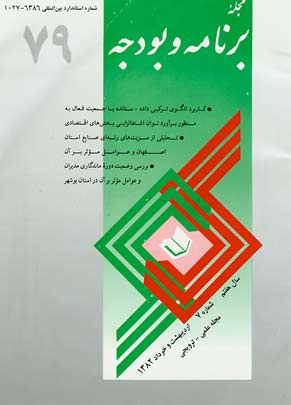فهرست مطالب

فصلنامه برنامه ریزی و بودجه
پیاپی 79 (اردیبهشت و خرداد 1382)
- 109 صفحه، بهای روی جلد: 5,000ريال
- تاریخ انتشار: 1382/03/15
- تعداد عناوین: 3
-
صفحه 3تا حدود سه دهه پیش آمارهای اقتصادی به صورت نظام مند - در قالب حساب های ملی و جدول داده - ستانده - می توانستند پاسخگوی نیازهای آماری و تحلیل های کمی دیدگاه های اقتصادی باشند که امروزه به دیدگاه های رشد محور معروفند. ولیکن به دلیل غیرحساس بودن دیدگاه های مذکور در بررسی هزمان مسائل اقتصادی و اجتماعی، توجهی به نظام مند کردن آمارهای اجتماعی در موازات آمارهای اقتصادی نشده و بدیون ترتیب در عمل، محدودیت هایی را در نظام های حسابداری موجود و دیدگاه های مرتبط به آن فراهم نموده بود...
-
صفحه 39در این مقاله، هدف تعیین جهت گیری تجاری صنایع استان اصفهان و ارتباط شاخص های مزیت نسبی و تغییرات آن با برخی ویژگی های صنعت در استان است. بدین منظور با به کارگیری روش های تحلیل عاملی، تجزیه به مولفه های اصلی و تاکسونومی عددی شاخص های تعیین کننده درجه توسعه صنعتی استان محاسبه شده و رتبه بندی براین اساس صورت گرفته است. همچنین به کمک شاخص های مناسب صنایع استان رتبه بندی و صنایع مزیت دار شناسایی گردیده اند.
-
صفحه 79در جهان پیچیده سازمان های امروزین، مدیریت بیش از هر زمان دیگری در میان چهار عامل کلیدی موفقیت سازمان ها(نیروی کار، سرمایه، مواد اولیه و مدیریت) برجسته می نماید. در حالی که سرمایه به دنبال سودآوری بیشتر، قاره به قاره ره می پیماید و تحولات تکنولوژیکی بشر از اهمیت مواد اولیه و نیروی کار کاسته است، آنچه که در صحنه های رقابت جهانی نقش تعیین کننده ای ایفا می نماید مدیریت است. مبتنی بر نقش والای مدیریت در توسعه و پیشرفت امور، ضرورتی بنیادین برای تحقیق و تفحص در این زمینه فراروی سازمان ها و محققان قرار داده شده است...
-
Page 3Up to three decades ago, economic statistics could systematically meet the statistical needs and economic views quantitative analyses requirements (known as growth – centered views) in the framework of national accounts and input-output tables. However, owing to the insensitivity of these views to simultaneous survey of socio-economic issues, no attention has been paid to systematizing social statistics in line with economic statistics and this has practically caused some restrictions in the present accounting systems and the views related to it. The appearance of new economic development with human-centered approach after 1970s proved the need for systematization and integration of socio-economic statistics more than ever. Therefore, different international agencies and researchers designed middle accounting system and a wide range of models related to it such as semi input-output model, social accounting matrix model and extended social accounting matrix model. One of the major distinctions of the population input-output model with other ones is that separating household consumption on the basis of employed and unemployed households in the above-mentioned model makes it possible to link productive activities and population in a matrix form that results in an interaction between Leontief input-output production balance and population balance. However, in other models, active population especially employment is imposed to the system from outside. This paper tries to design a population input-output model with partial modifications and operationalization by the use of 2000 modified input – output table and minor statistics such as employment in order to estimate the number of potential employment opportunities provided for non-employed households in different economic sectors. The results of the study reveal that socio-economic and development policies in textile, clothing and leather, agriculture and food industries have priorities as far as the increase of job opportunities for the unemployed households is concerned.
-
Page 39This paper aims at determining Isfahan provincial industries orientation as well as relating the comparative advantage indexes and their changes with the province’s industrial characteristics. Therefore, applying “factor analysis”, “principal components analysis” and “numerical taxonomy analysis” methods, the paper calculates the determining indexes of the province’s industrial development and offers a ranking on this basis. The provincial industries have been ranked and the advantageous industries identified by the use of the appropriate indexes.
-
Page 79In the modern world’s complicated organizations, management seems more outstanding than ever, compared with other three key organizational factors i.e. labour, capitals and raw materials. While the capitals span the continents in search of more profits, and human technological developments degrade the importance of raw materials, management has become a factor that plays a determining role in the world’s competitive era. Playing a highly recognizable role in development and advances, management is regarded an essential need to do researches on this challenging matter that organizations and researchers confront with. According to the studies undertaken to rank the provinces in Iran, seven provinces have been identified as the less-developed ones whose managerial situations have always been assumed as one of the factors of the problem by the researchers and planners. Lack of a suitable environment for retaining managers, inappropriate designations of managers, cultural restrictions, insufficient facilities, etc are some of the factors that could have a major role in the matter. Hence, it necessitates a research on the ways of managers’ selection and designation in the less-developed provinces using a retrospective view to face the problem seriously. This paper particularly tries to study retrospectively the management problems in Boushehr as a less-developed province. It intends to find the average office terms of managers and to survey the factors influencing their office terms as well.

